Understanding the Intensity of Land-Use and Land-Cover Changes in the Context of Postcolonial and Socialist Transformation in Kaesong, North Korea
Abstract
:1. Introduction
- Considering the colonization by Imperial Japan and the South–North division, which of the two historical periods underwent more dynamic LUCCs?
- Which land category went through the most intensive changes in the study area?
- Were there any land transitions that clearly showed patterns of targeting or avoidance, regardless of historical period?
2. Geographical Scope and Land-Use Changes in Kaesong and the DMZ
3. Materials and Methods
3.1. Study Area
3.2. Land-Cover Maps
3.3. Intensity Analysis
4. Results
4.1. Change Detection Analysis
4.2. Interval Level Intensity
4.3. Category Level Intensity
4.4. Transition Level Intensity
5. Discussion
6. Conclusions
Author Contributions
Funding
Acknowledgments
Conflicts of Interest
Appendix A
Appendix A.1. Interval Level Intensity
Appendix A.2. Category Level Intensity
Appendix A.3. Transition Level Intensity
References
- Meyfroidt, P.; Chowdhury, R.R.; de Bremond, A.; Ellis, E.; Erb, K.-H.; Filatova, T.; Garrett, R.; Grove, J.; Heinimann, A.; Kuemmerle, T.; et al. Middle-range theories of land system change. Glob. Environ. Chang. 2018, 53, 52–67. [Google Scholar] [CrossRef]
- Veldkamp, A.; Verburg, P. Modelling land use change and environmental impact. J. Environ. Manag. 2004, 72, 1–3. [Google Scholar] [CrossRef]
- Lambin, E.F.; Turner, B.L.; Geist, H.J.; Agbola, S.B.; Angelsen, A.; Bruce, J.W.; Coomes, O.T.; Dirzo, R.; Fischer, G.; Folke, C.; et al. The causes of land-use and land-cover change: Moving beyond the myths. Glob. Environ. Chang. 2001, 11, 261–269. [Google Scholar] [CrossRef]
- Meerow, S.; Newell, J.P.; Stults, M. Defining urban resilience: A review. Landsc. Urban Plan. 2016, 147, 38–49. [Google Scholar] [CrossRef]
- Seto, K.C.; Güneralp, B.; Hutyra, L.R. Global forecasts of urban expansion to 2030 and direct impacts on biodiversity and carbon pools. Proc. Natl. Acad. Sci. USA 2012, 109, 16083–16088. [Google Scholar] [CrossRef] [Green Version]
- Montgomery, M.R. The urban transformation of the developing world. Science 2008, 319, 761–764. [Google Scholar] [CrossRef] [Green Version]
- Quan, B.; Pontius, R.G., Jr.; Song, H. Intensity Analysis to communicate land change during three time intervals in two regions of Quanzhou city, China. GIScience Remote Sens. 2020, 57, 21–36. [Google Scholar] [CrossRef]
- He, J.; Xu, J. Is there decentralization in North Korea? Evidence and lessons from the sloping land management program 2004–2014. Land Use Policy 2017, 61, 113–125. [Google Scholar] [CrossRef]
- Huang, X.; Schneider, A.; Friedl, M.A. Mapping sub-pixel urban expansion in China using MODIS and DMSP/OLS nighttime lights. Remote Sens. Environ. 2016, 175, 92–108. [Google Scholar] [CrossRef]
- Schneider, A.; Mertes, C.M.; Tatem, A.J.; Tan, B.; Sullamenashe, D.; Graves, S.J.; Patel, N.N.; Horton, J.A.; Gaughan, A.E.; Rollo, J.T.; et al. A new urban landscape in East–Southeast Asia, 2000–2010. Environ. Res. Lett. 2015, 10, 034002. [Google Scholar] [CrossRef]
- Schneider, A.; Mertes, C.M. Expansion and growth in Chinese cities, 1978–2010. Environ. Res. Lett. 2014, 9, 024008. [Google Scholar] [CrossRef]
- Kontgis, C.; Schneider, A.; Fox, J.; Saksena, S.; Spencer, J.H.; Castrence, M. Monitoring peri-urbanization in the greater Ho Chi Minh city metropolitan area. Appl. Geogr. 2015, 53, 377–388. [Google Scholar] [CrossRef]
- Schneider, A.; Seto, K.C.; Webster, D.R. Urban growth in Chengdu, Western China: Application of remote sensing to assess planning and policy outcomes. Environ. Plan. B Plan. Des. 2005, 32, 323–345. [Google Scholar] [CrossRef]
- Kim, O.S.; Newell, J. The ‘Geographic Emission Benchmark’ model: A baseline approach to measuring emissions associated with deforestation and degradation. J. Land Use Sci. 2014, 10, 466–489. [Google Scholar] [CrossRef] [Green Version]
- Kim, O.S.; Nugent, J.B.; Yi, Z.-F.; Newell, J.P.; Curtis, A.J. A mixed application of geographically weighted regression and unsupervised classification for analyzing latex yield variability in Yunnan, China. Forests 2017, 8, 162. [Google Scholar] [CrossRef] [Green Version]
- Kang, S.; Choi, J.; Yoon, H.; Choi, W. Changes in the extent and distribution of urban land cover in the Democratic People’s Republic of Korea (North Korea) between 1987 and 2010. Land Degrad. Dev. 2019, 30, 2009–2017. [Google Scholar] [CrossRef]
- Jeong, S.K.; Lee, T.H.; Ban, Y.U. Characteristics of spatial configurations in Pyongyang, North Korea. Habitat Int. 2015, 47, 148–157. [Google Scholar] [CrossRef]
- Kim, O.S.; Neubert, M. Construction of a Historical Map Database as a Basis for Analyzing Land-Use and Land-Cover Changes, Exemplified by the Korean Demilitarized Zone and Inner-German Green Belt (Part 1); Korea Environment Institute: Sejong, Korea, 2018. [Google Scholar]
- Jung, H.C.; Yoon, J.H.; Lee, M.J.; Kim, G.H.; Jang, R.I.; Kang, B.J.; Kim, N.K.; Byun, H.K.; Na, S.J. Construction and Utilization of Environmental Information in Inaccessible Terrain: Focused on Construction of Land Cover Map; Korea Environment Institute: Sejong, Korea, 2015. (In Korean) [Google Scholar]
- Kim, Y.P.; Park, S.M.; Han, S.H. Land Use Interpretation using High Resolution Satellite Imagery of Kaeseong, North Korea; Korea Research Institute for Human Settlements: Sejong, Korea, 2001. (In Korean) [Google Scholar]
- Seo, C.W.; Jeon, S.W. Landcover analysis of DMZ and the vicinity using remote sensing and GIS techniques. Environ. Impact Assess. 1998, 7, 11–22. (In Korean) [Google Scholar]
- Kim, O.S.; Chun, D.J.; Kim, G.H.; Song, S.K.; Kim, C.M.; Kim, J.H.; Jung, C.Y.; Jang, K.H. Setting Research Directions to Pursue Sustainable Land-Use of Korean Demilitarized Zone; Korea Environment Institute: Sejong, Korea, 2019. (In Korean) [Google Scholar]
- Yang, J.P. Korean commercial dominance and its features in colonial Gaesung. Crit. Stud. Mod. Korean Hist. 2012, 27, 141–174. (In Korean) [Google Scholar]
- Park, S.Y. Gaeseong as a socialist city: What was changed, and what was not. Q. Rev. Korean Hist. 2015, 98, 341–379. (In Korean) [Google Scholar]
- Aldwaik, S.Z.; Pontius, R.G., Jr. Intensity analysis to unify measurements of size and stationarity of land changes by interval, category, and transition. Landsc. Urban Plan. 2012, 106, 103–114. [Google Scholar] [CrossRef]
- Park, J.W. A Study on the Prediction of Land Use and Land Cover Change in the Northern Area of the Civilian Control Line of DMZ Using GIS and RS; Kangwon National University: Gangwon, Korea, 2017. (In Korean) [Google Scholar]
- Park, J.; Sim, W.; Park, J.; Lee, J. Object-based land cover change detection and landscape structure analysis of Demilitarized Zone in Korea. Sensors Mater. 2019, 31, 3733. [Google Scholar] [CrossRef]
- Democratic People’s Republic of Korea. Nomination of the Historic Monuments and Sites in Kaesong for Inscription on the World Heritage List; National Bureau for Cultural Property Conservation: Pyongyang, North Korea, 2013.
- Ministry of Unification. Master Plan of the Kaesong Industrial Complex (in Korean). 2016. Available online: https://www.unikorea.go.kr/unikorea/business/kaesongIndustrialComplex/status/promotion/ (accessed on 8 October 2021).
- Korea Meteorological Administration. Korean Climate Data. 2022. Available online: https://www.weather.go.kr/weather/climate/average_north.jsp?pg=24&do=07&si=2 (accessed on 10 January 2022).
- Kienast, F.; Frank, C.; Leu, R. Analyse raum-zeitlicher Daten mit einem Geographischen Informationssystem, Berichte der Eidgenössischen Forschungsanstalt für Wald. Schnee Landsch. 1991, 328, 36. [Google Scholar]
- Aldwaik, S.Z.; Pontius, R.G., Jr. Map errors that could account for deviations from a uniform intensity of land change. Int. J. Geogr. Inf. Sci. 2013, 27, 1717–1739. [Google Scholar] [CrossRef]
- Pontius, R.G., Jr.; Santacruz, A. Quantity, exchange, and shift components of difference in a square contingency table. Int. J. Remote Sens. 2014, 35, 7543–7554. [Google Scholar] [CrossRef]
- Pontius, R.G., Jr.; Millones, M. Death to Kappa: Birth of quantity disagreement and allocation disagreement for accuracy assessment. Int. J. Remote Sens. 2011, 32, 4407–4429. [Google Scholar] [CrossRef]
- Statistics Korea. Democratic People’s Republic of Korea Statistics Portal. 2021. Available online: https://kosis.kr/bukhan/index/index.do (accessed on 8 October 2021).
- Spoorenberg, T.; Schwekendiek, D. Demographic changes in North Korea: 1993–2008. Popul. Dev. Rev. 2012, 38, 133–158. [Google Scholar] [CrossRef]
- Seo, Y.S. An outcome of nature-reorganization policy in North Korea. N. Korean Stud. 2008, 4, 103–128. (In Korean) [Google Scholar]
- Park, M.S.; Lee, H. Forest policy and law for sustainability within the Korean Peninsula. Sustainability 2014, 6, 5162–5186. [Google Scholar] [CrossRef] [Green Version]
- Engler, R.; Teplyakov, V.; Adams, J.M. An assessment of forest cover trends in South and North Korea, from 1980 to 2010. Environ. Manag. 2014, 53, 194–201. [Google Scholar] [CrossRef]
- Chosen Government General of Imperial Japan. Joseon Civil Engineering Records. 1937. Available online: https://www.nl.go.kr/EN/main/index.do (accessed on 8 November 2021). (In Chinese)
- Choi, W.; Kang, S.; Choi, J.; Larsen, J.J.; Oh, C.; Na, Y.-G. Characteristics of deforestation in the Democratic People’s Republic of Korea (North Korea) between the 1980s and 2000s. Reg. Environ. Chang. 2017, 17, 379–388. [Google Scholar] [CrossRef]
- Cvitanović, M.; Lučev, I.; Fürst-Bjeliš, B.; Borčić, L.S.; Horvat, S.; Valožić, L. Analyzing post-socialist grassland conversion in a traditional agricultural landscape–Case study Croatia. J. Rural Stud. 2017, 51, 53–63. [Google Scholar] [CrossRef] [Green Version]
- Gutman, G.; Radeloff, V. Land-cover and land-use changes in Eastern Europe after the collapse of the Soviet Union in 1991. In Land-Cover and Land-Use Changes in Eastern Europe after the Collapse of the Soviet Union in 1991; Springer: Berlin/Heidelberg, Germany, 2016; pp. 1–247. [Google Scholar]
- Kanianska, R.; Kizeková, M.; Nováček, J.; Zeman, M. Land-use and land-cover changes in rural areas during different political systems: A case study of Slovakia from 1782 to 2006. Land Use Policy 2014, 36, 554–566. [Google Scholar] [CrossRef]
- Baumann, M.; Kuemmerle, T.; Elbakidze, M.; Ozdogan, M.; Radeloff, V.C.; Keuler, N.S.; Prishchepov, A.; Kruhlov, I.; Hostert, P. Patterns and drivers of post-socialist farmland abandonment in Western Ukraine. Land Use Policy 2011, 28, 552–562. [Google Scholar] [CrossRef]
- Václavík, T.; Rogan, J. Identifying trends in land use/land cover changes in the context of post-socialist transformation in central Europe: A case study of the greater Olomouc region, Czech Republic. GIScience Remote Sens. 2009, 46, 54–76. [Google Scholar] [CrossRef] [Green Version]
- Václavík, T. Mapping land-use/land-cover change in the Olomouc region, Czech Republic. J. Urban Reg. Inf. Syst. Assoc. 2008, 20, 45–51. [Google Scholar]
- Cegielska, K.; Noszczyk, T.; Kukulska, A.; Szylar, M.; Hernik, J.; Dixon-Gough, R.; Jombach, S.; Valánszki, I.; Kovács, K.F. Land use and land cover changes in post-socialist countries: Some observations from Hungary and Poland. Land Use Policy 2018, 78, 1–18. [Google Scholar] [CrossRef]
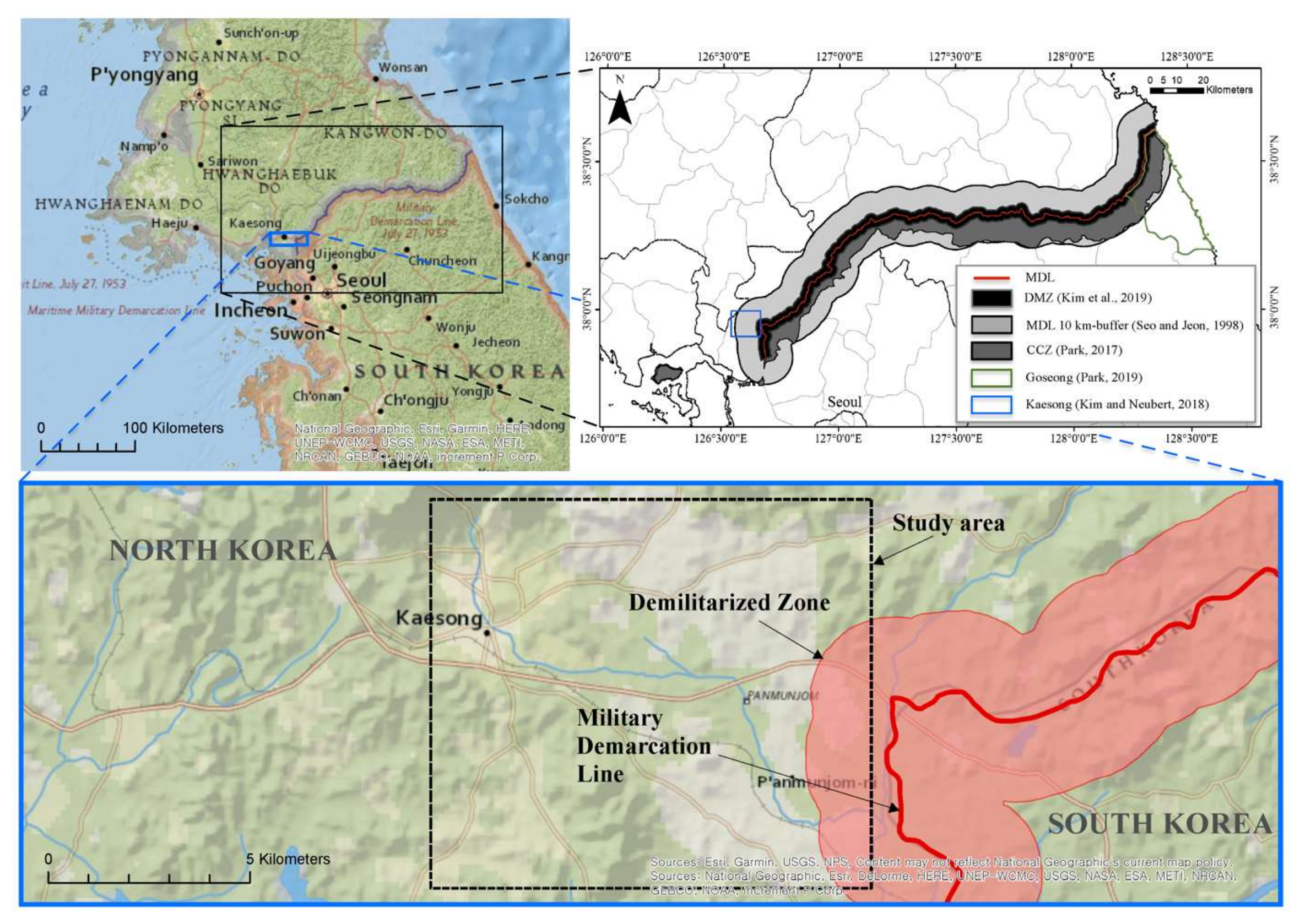
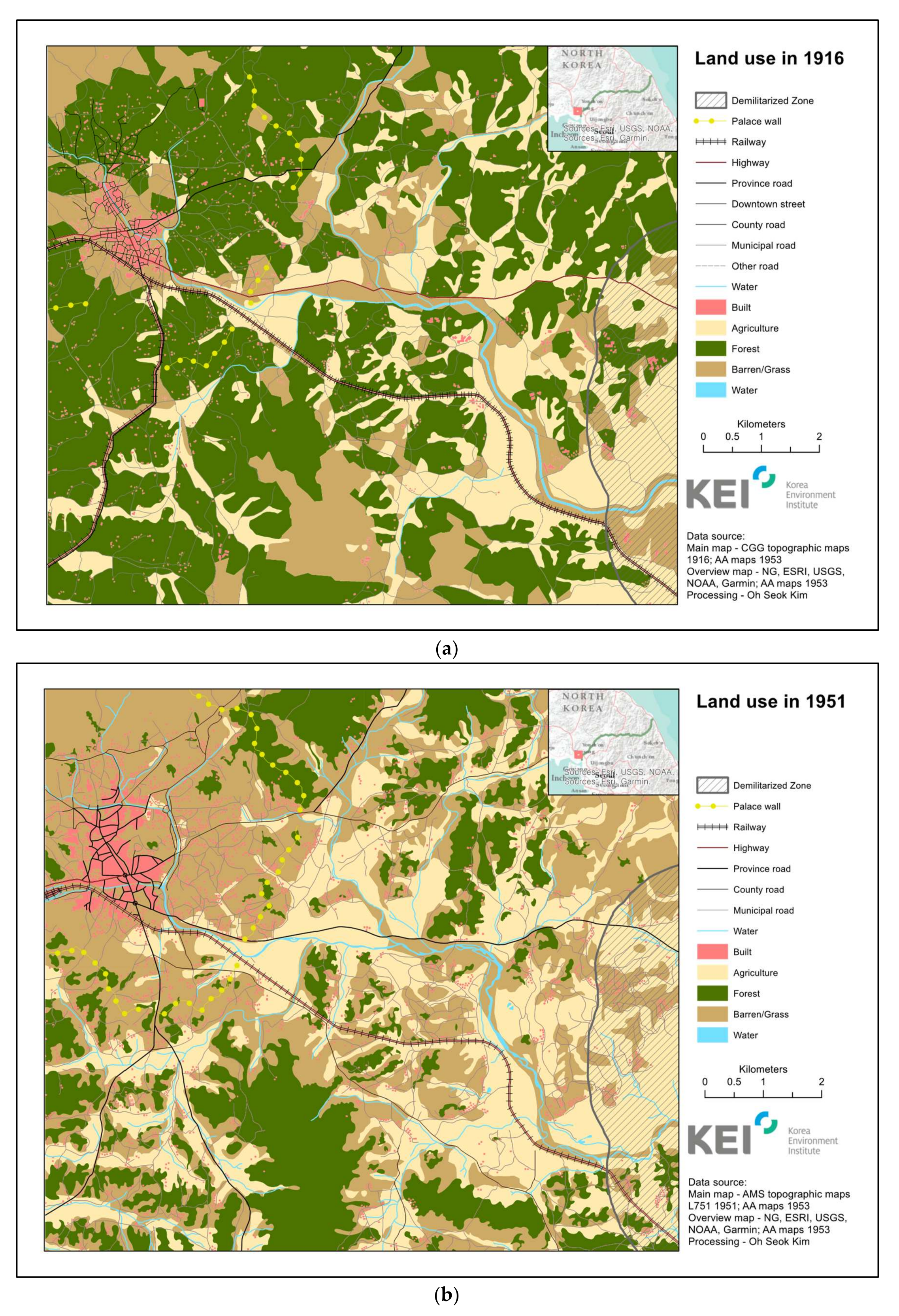
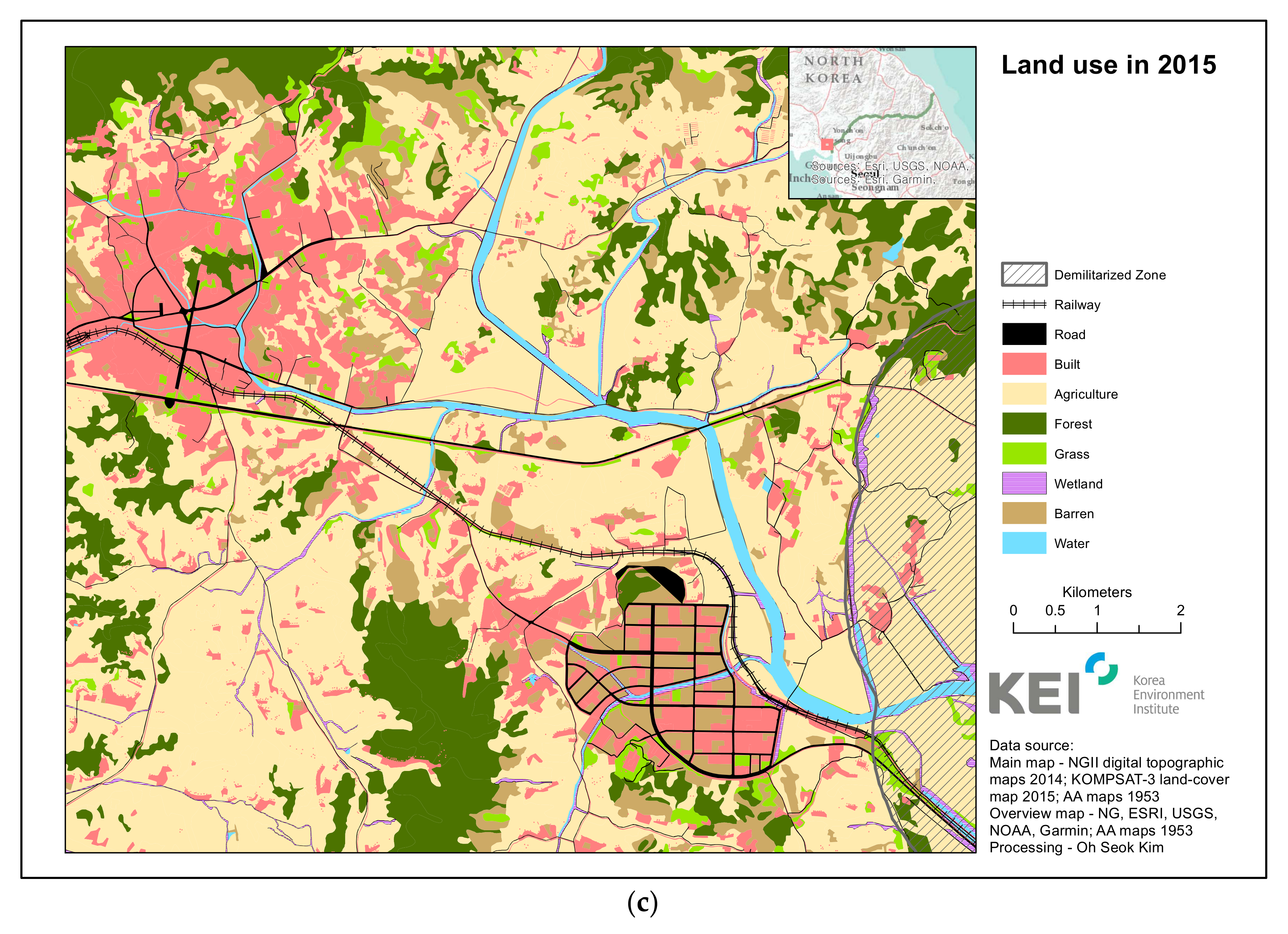
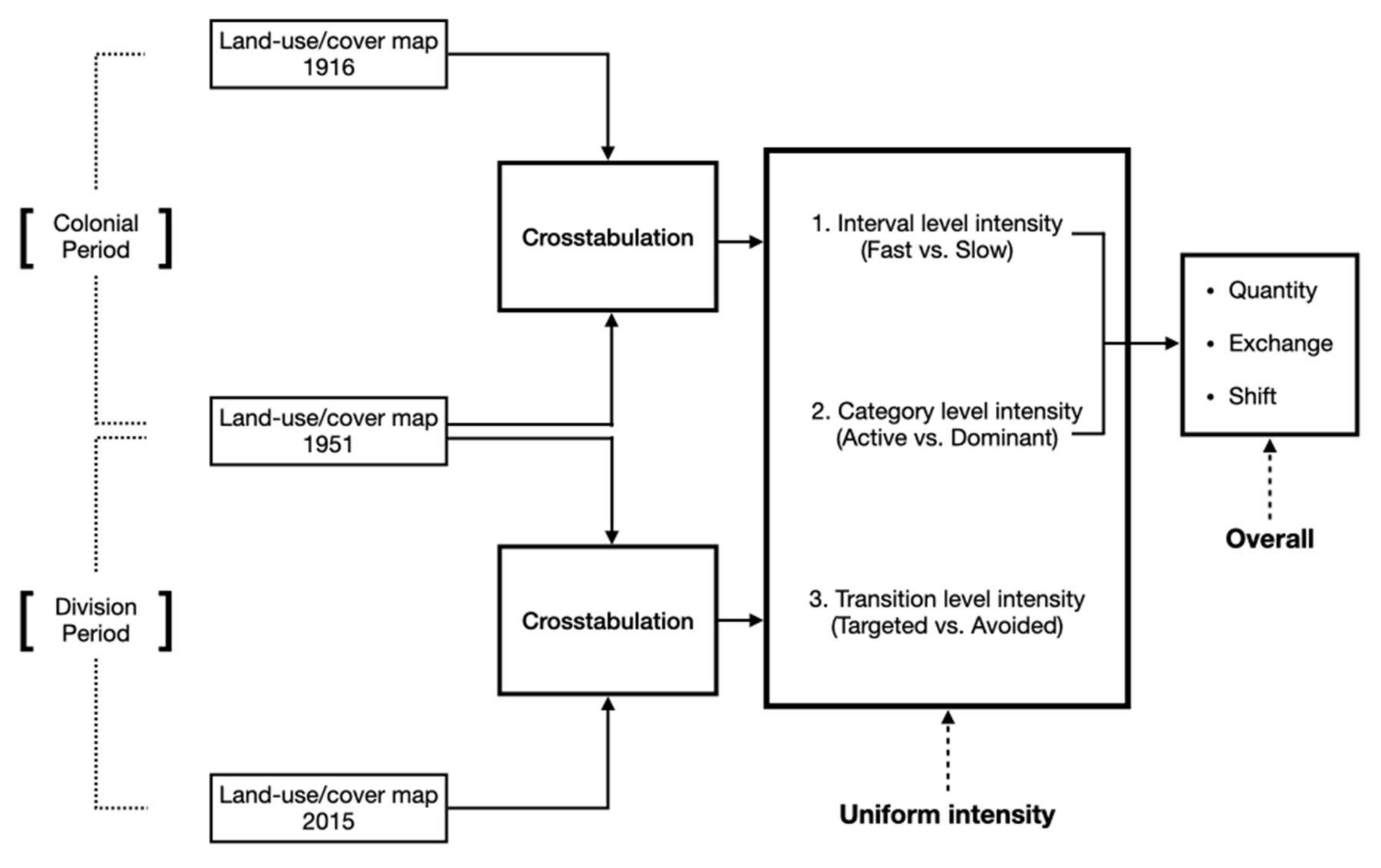
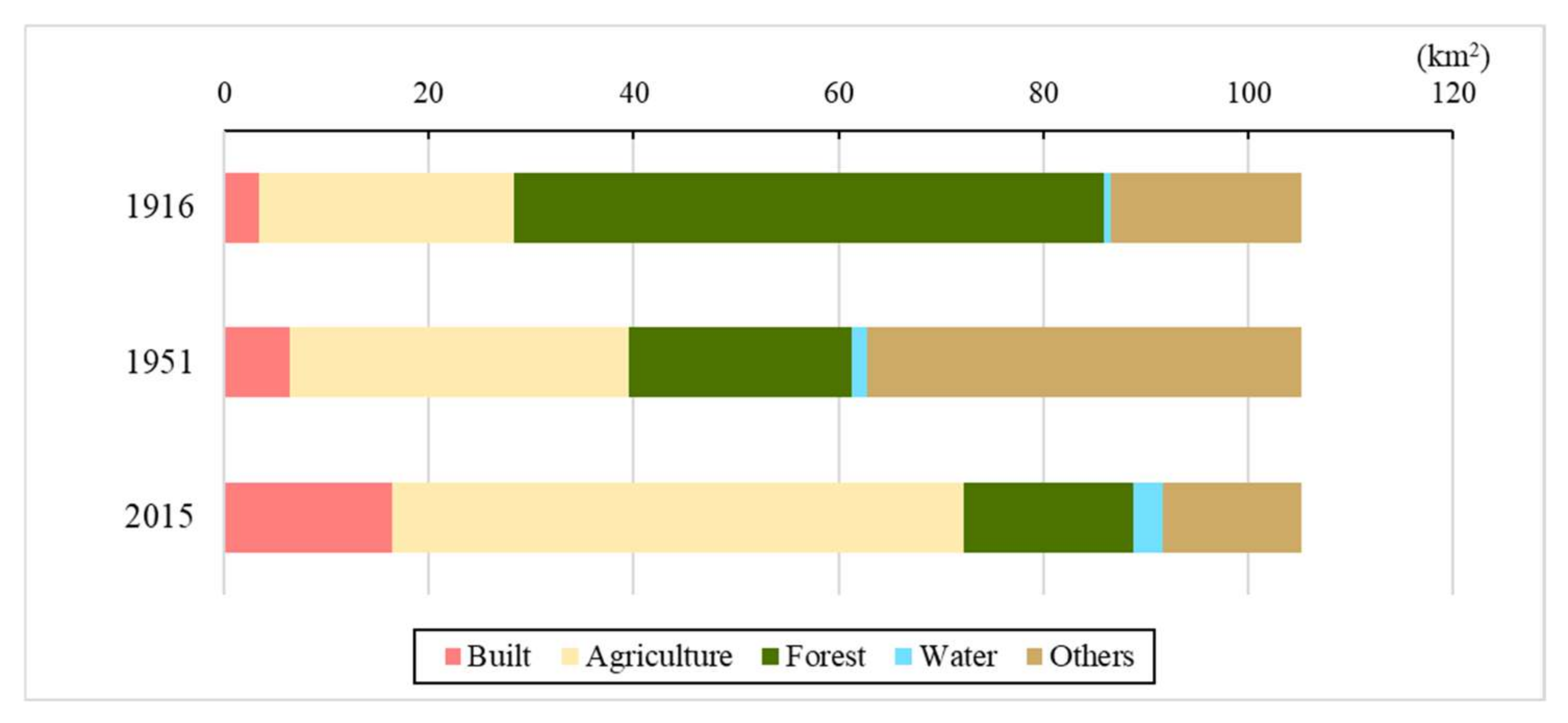
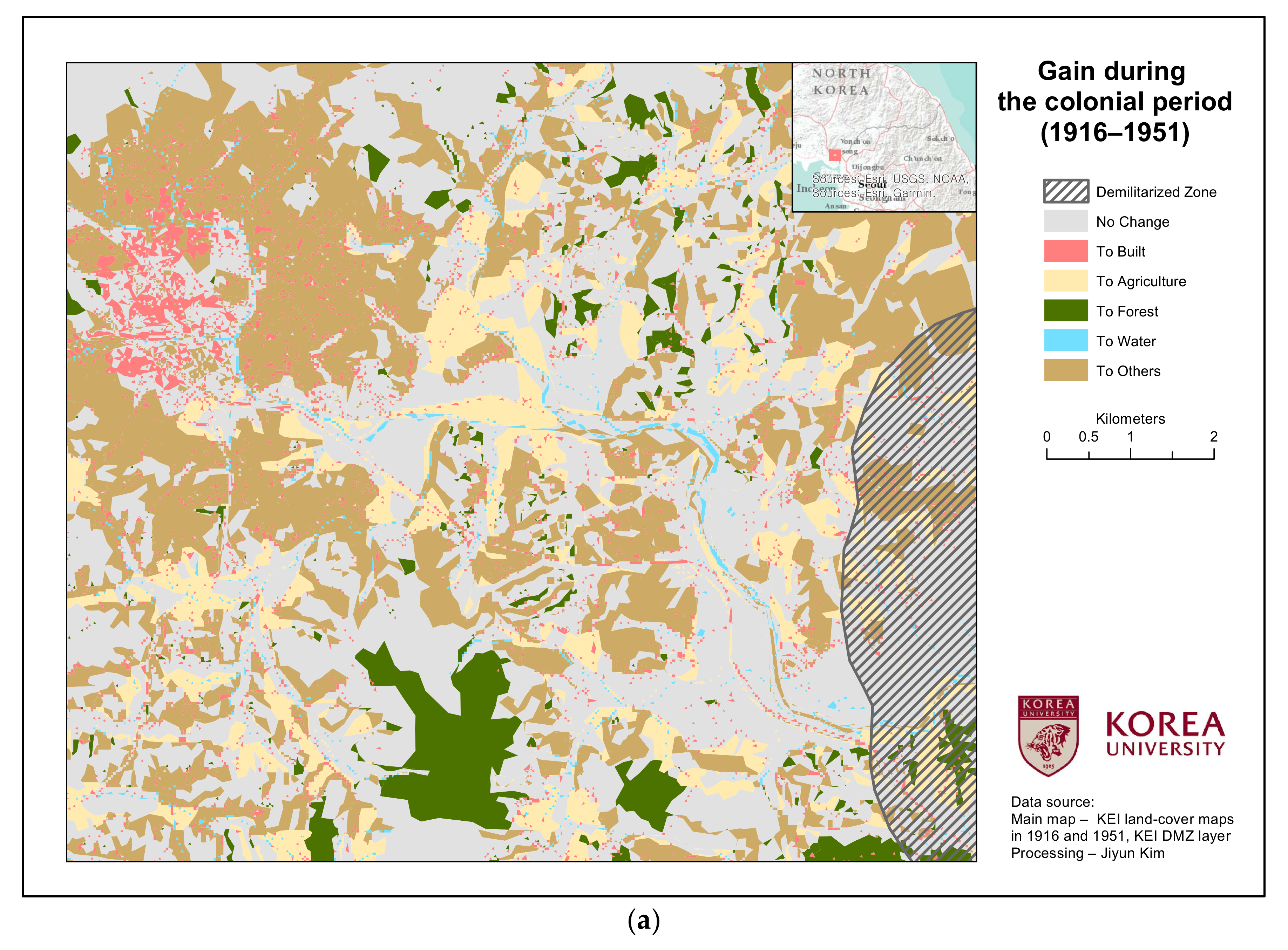
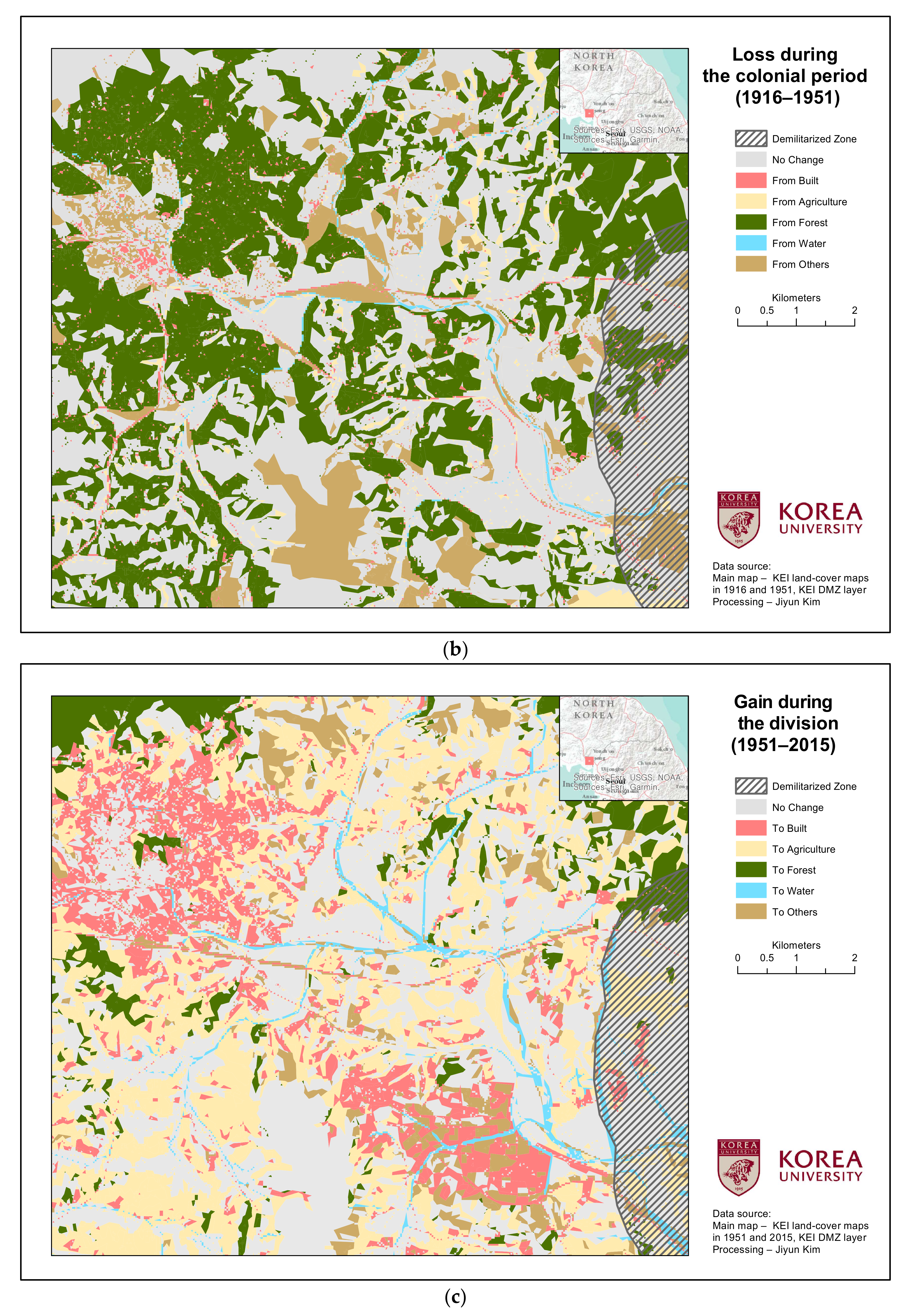
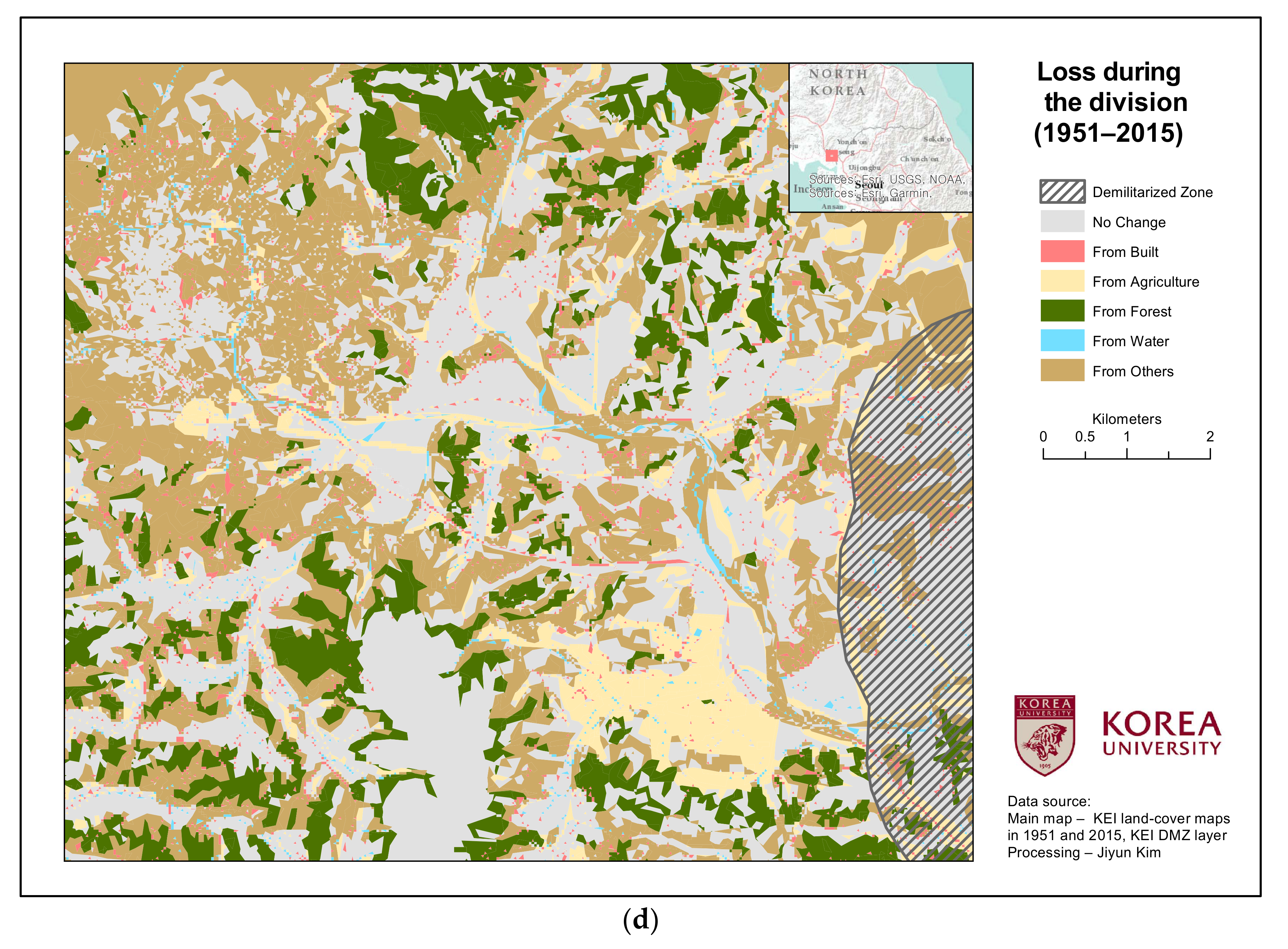

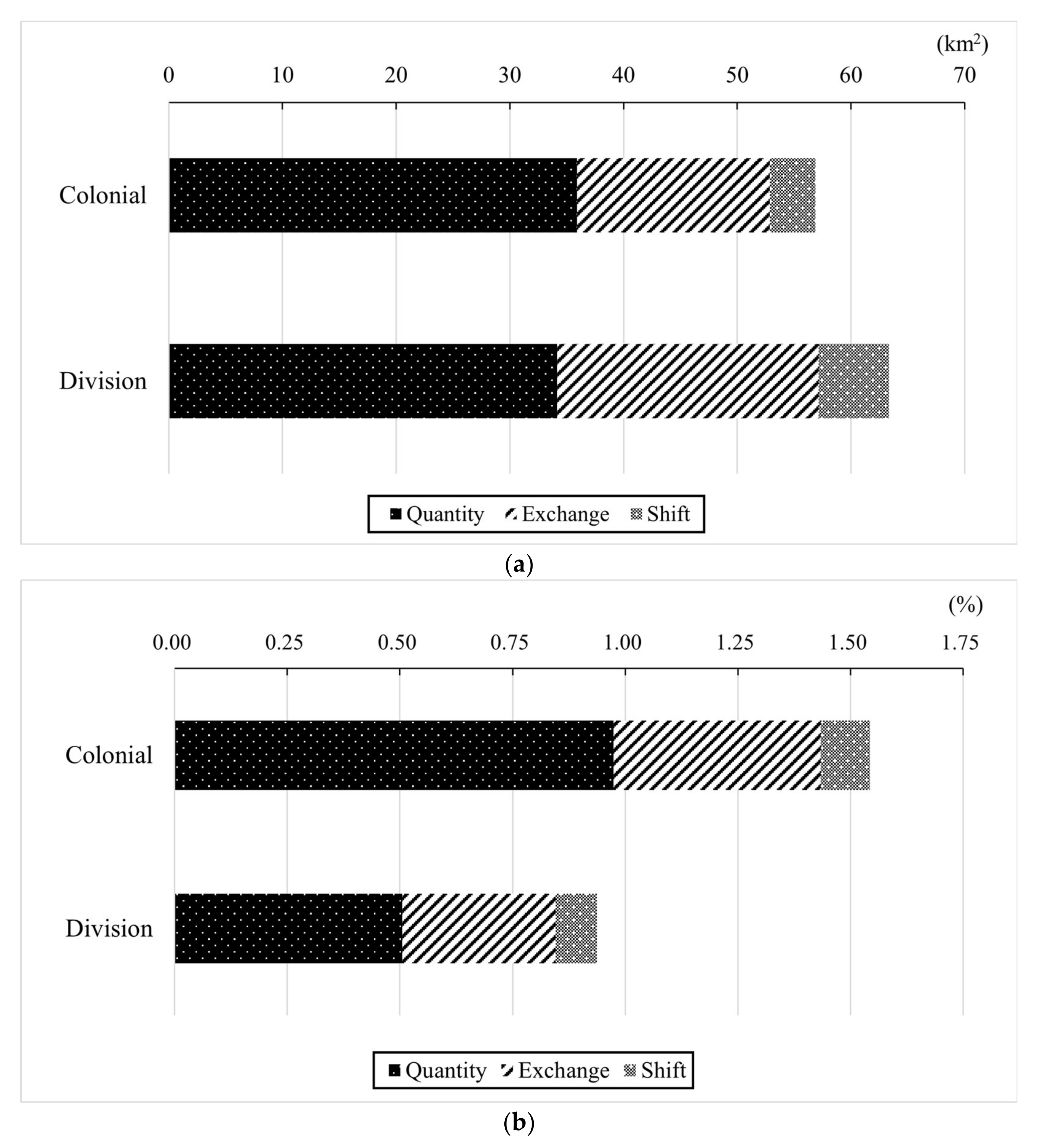

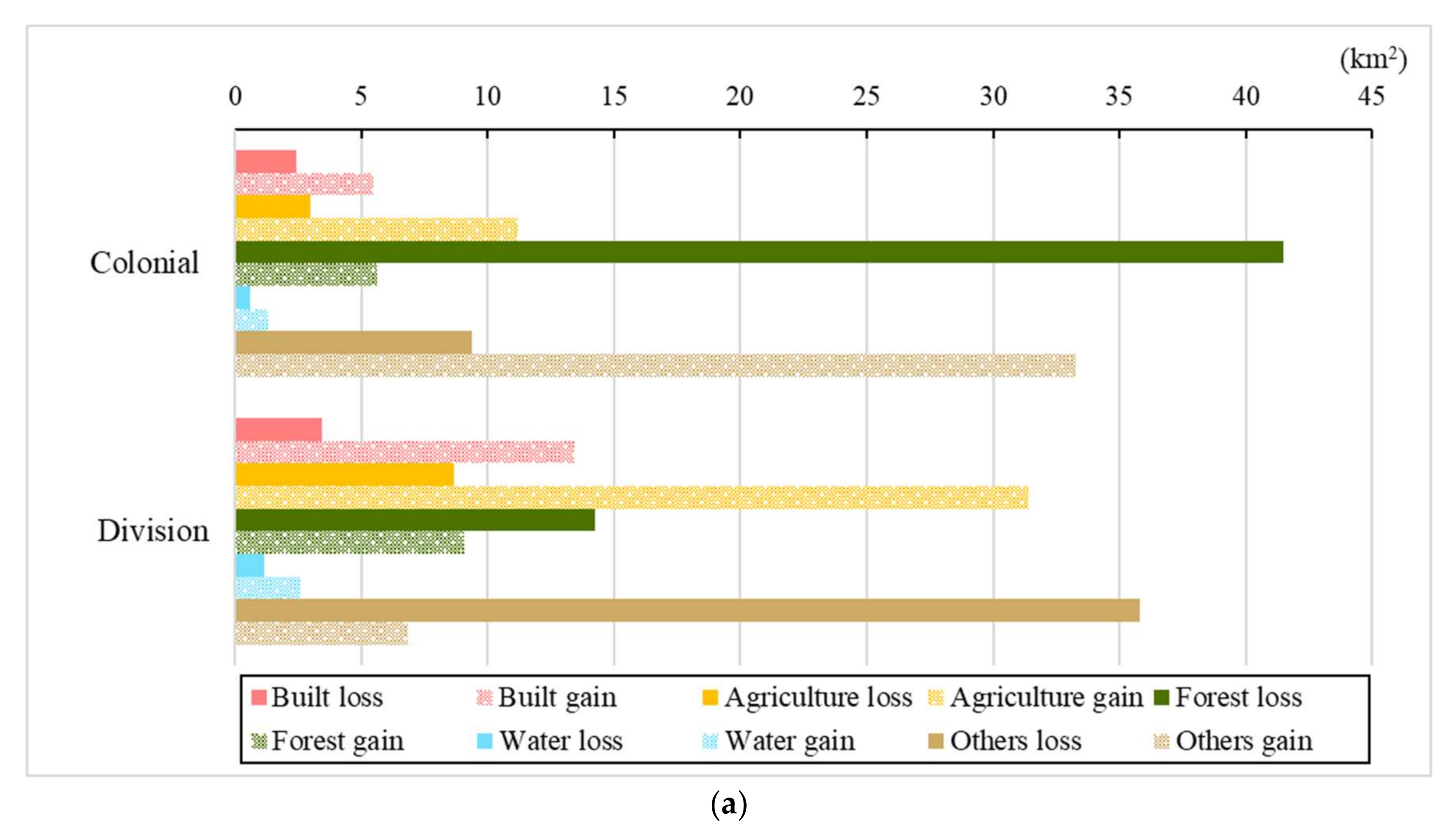
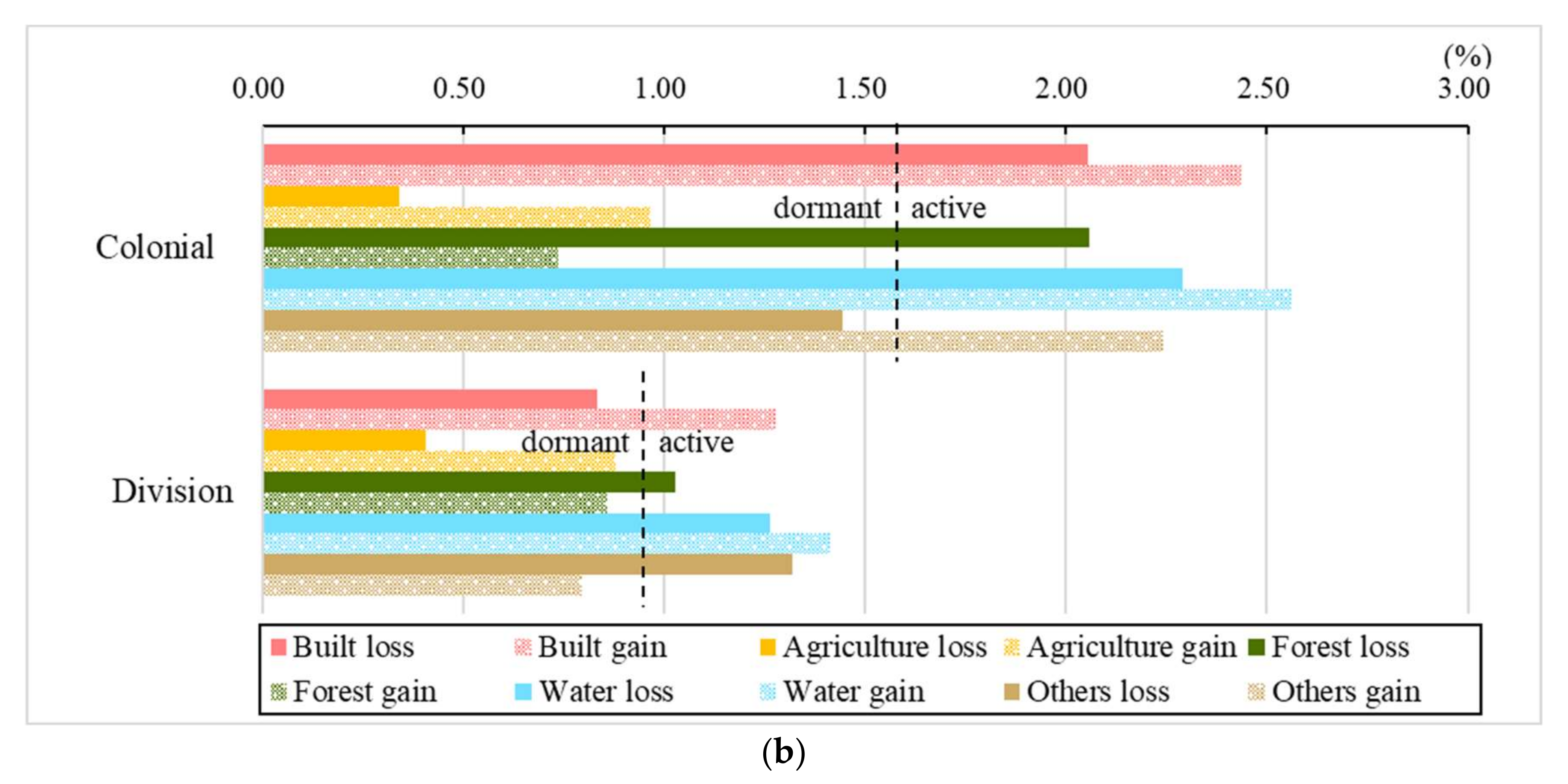
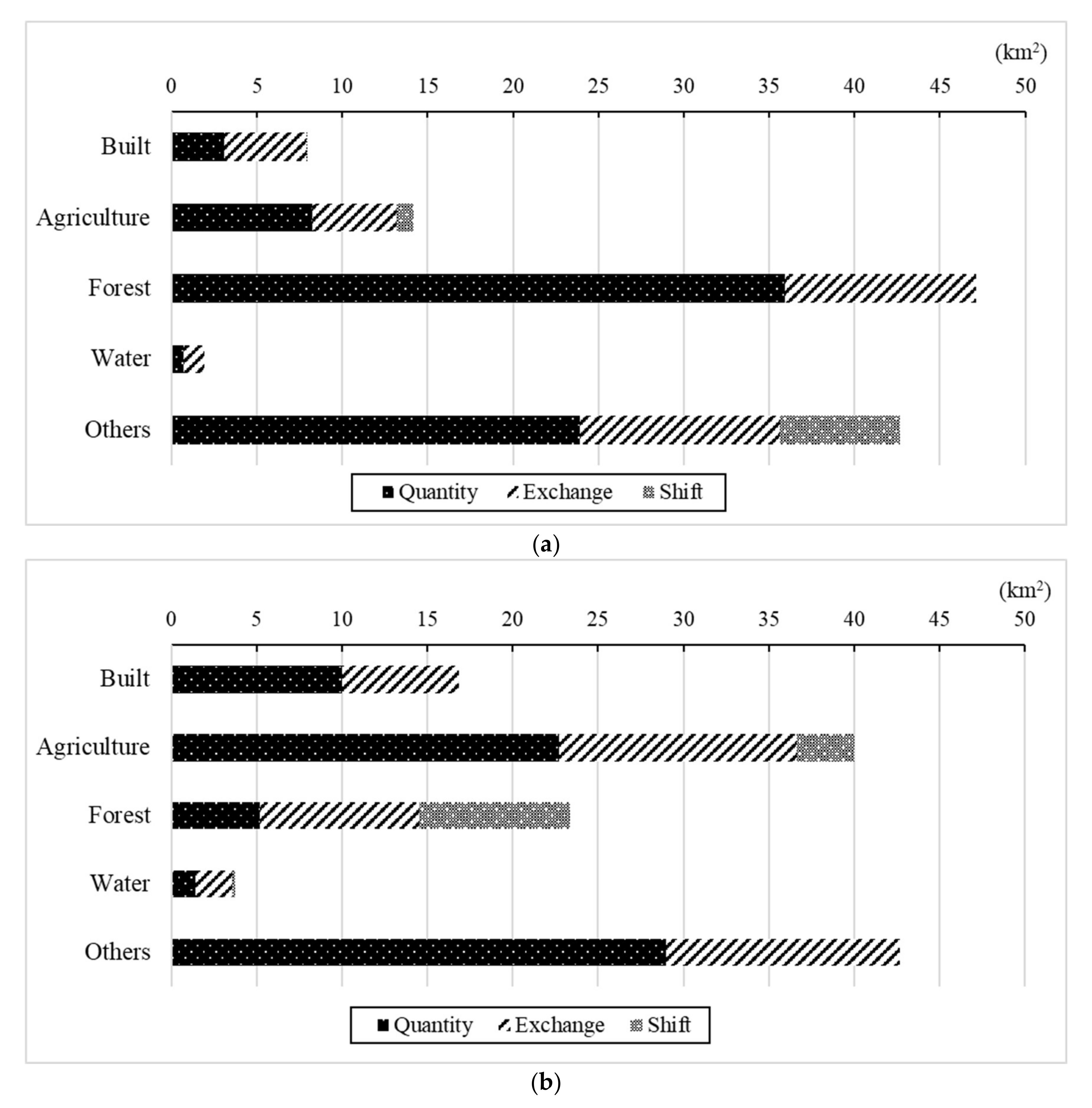
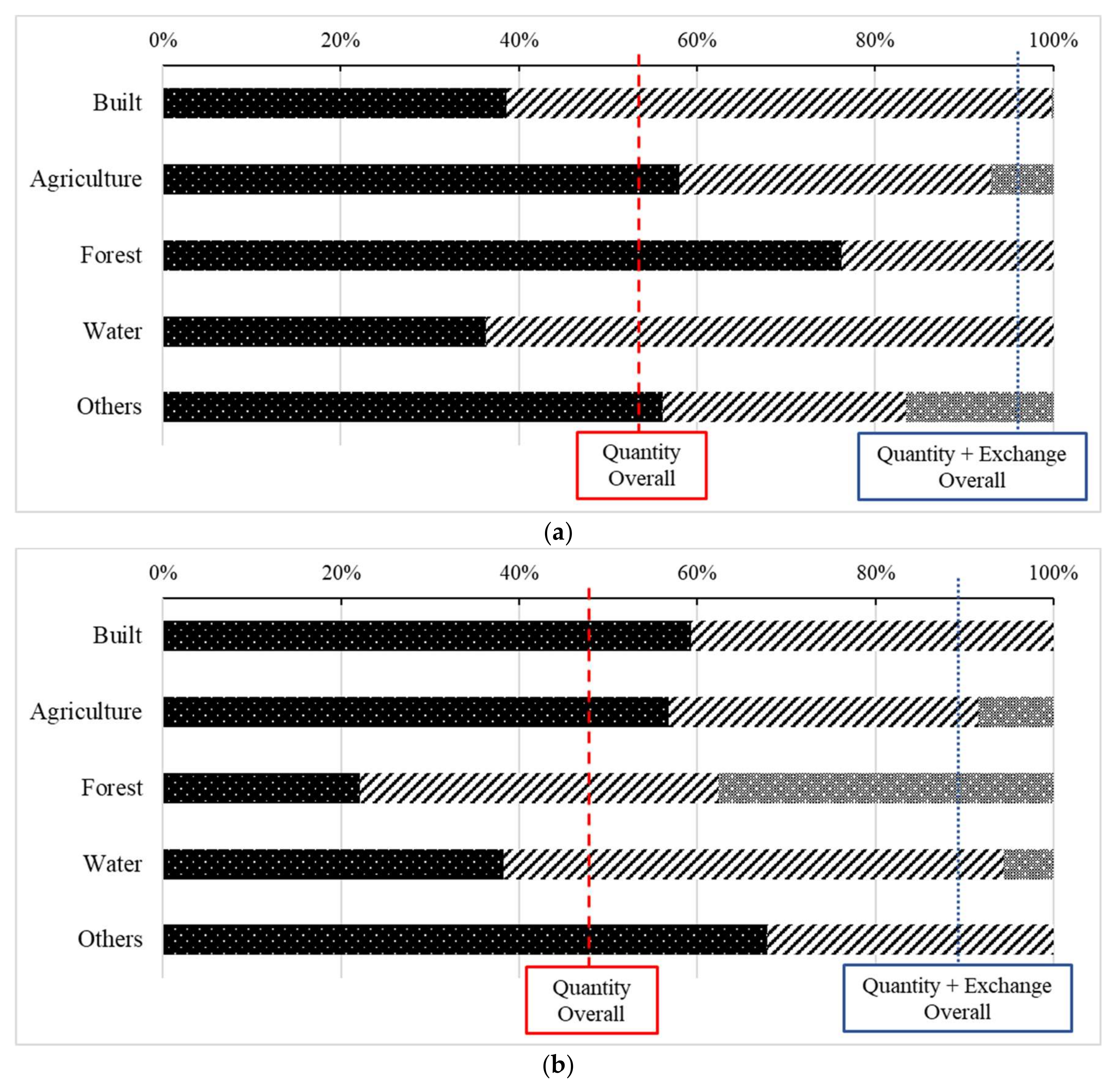
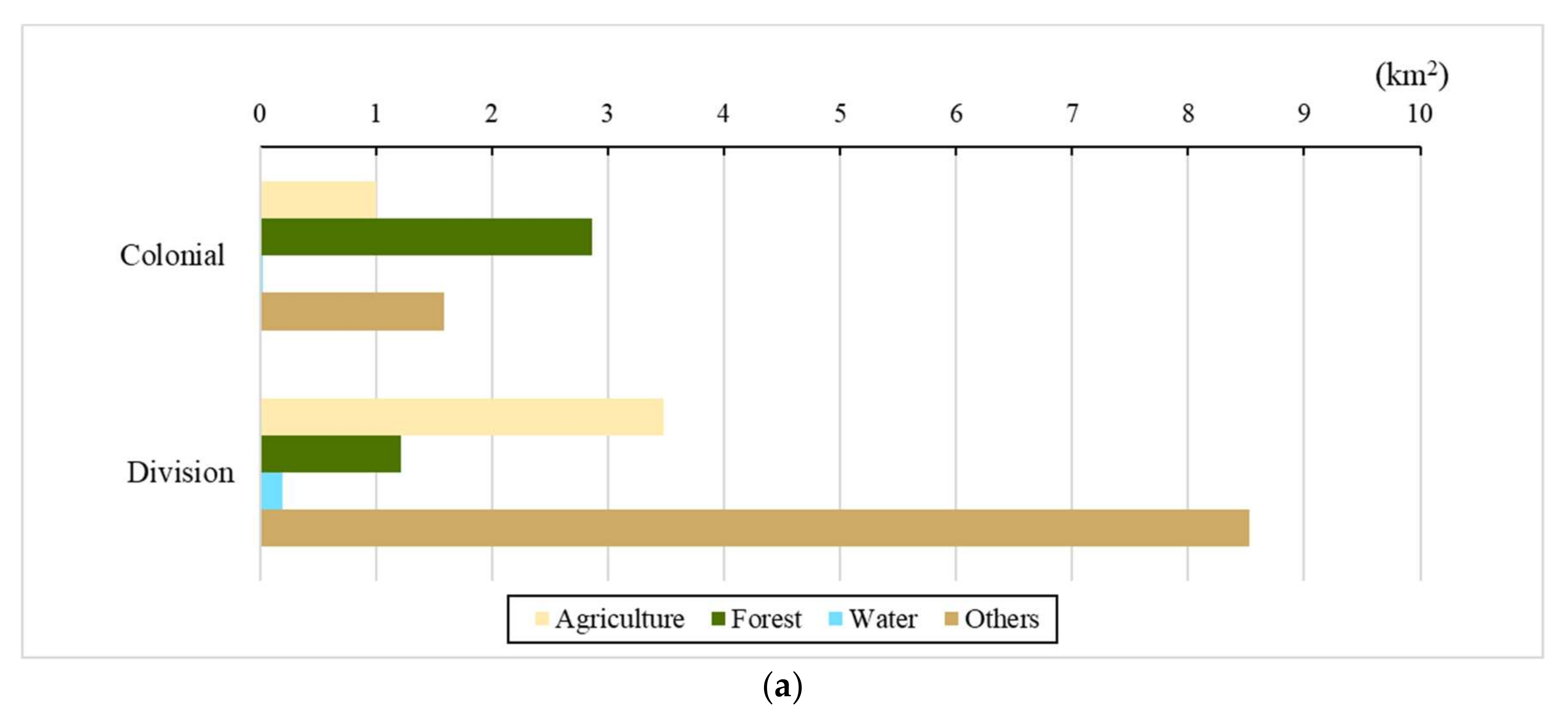
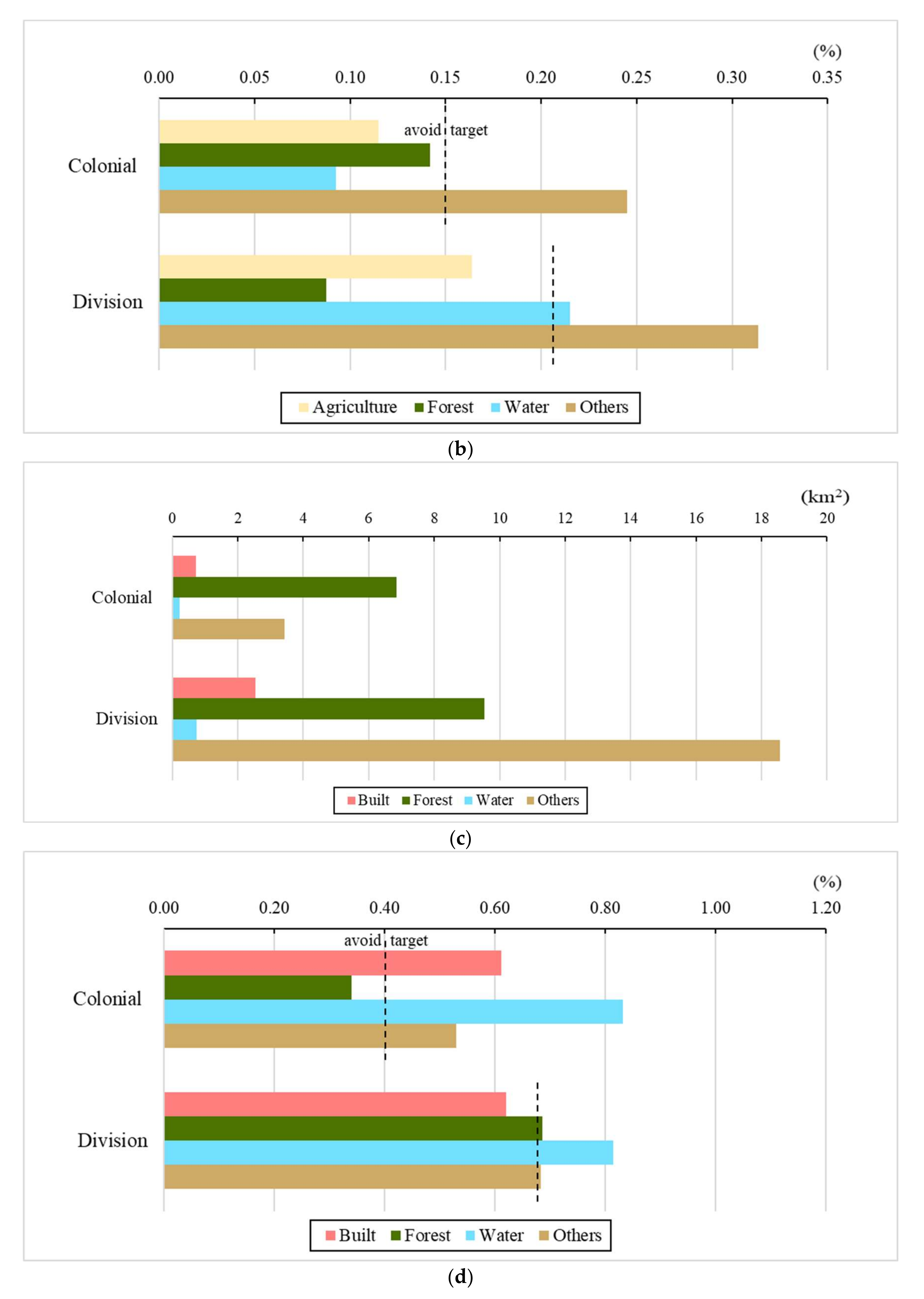
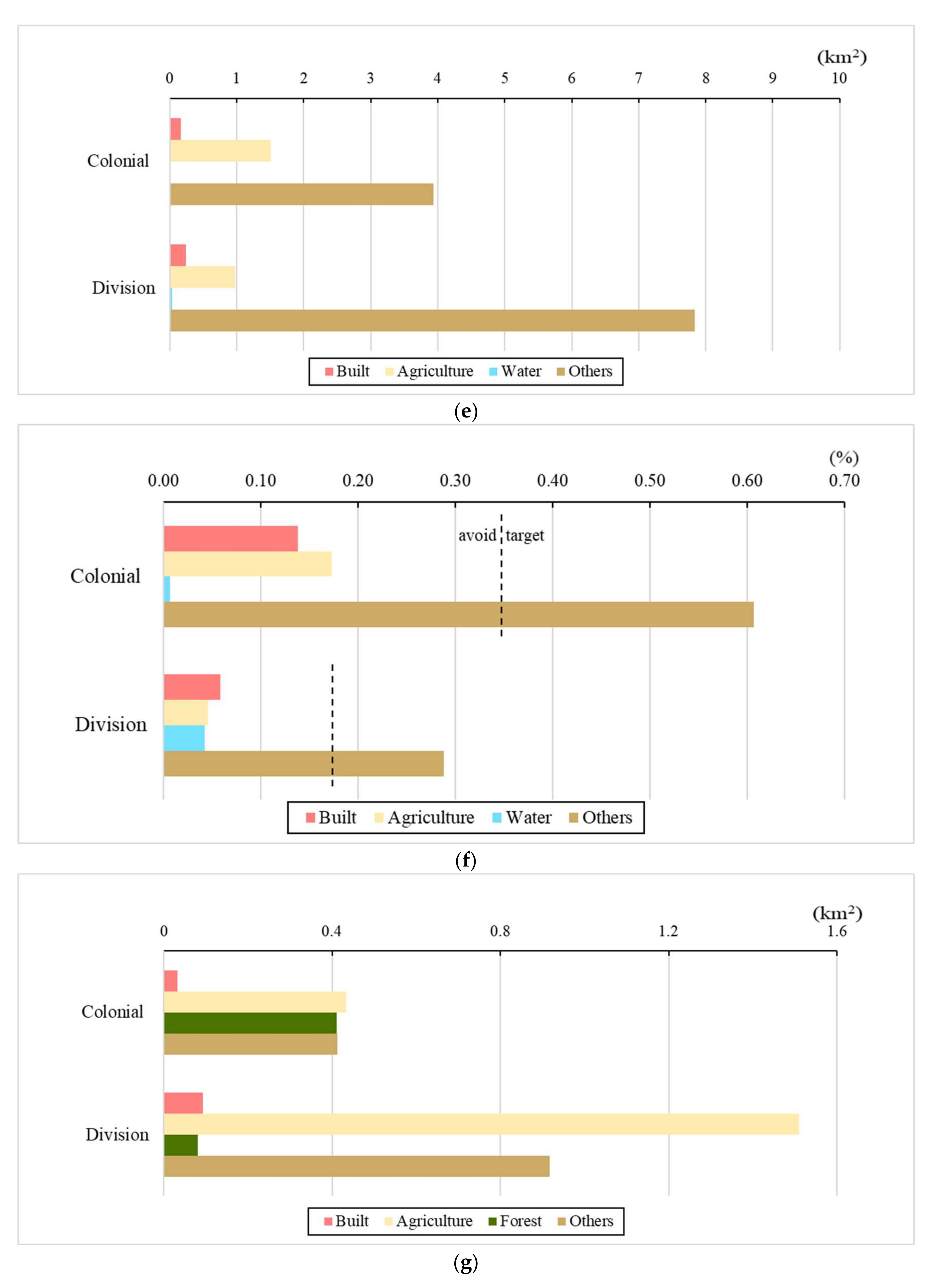

| Category at Beginning of Period | Category at End of Period | Initial Total | Gross Loss | |||||
|---|---|---|---|---|---|---|---|---|
| Built | Agriculture | Forest | Water | Others | ||||
| (a) Colonial period (1916–1951) | Built | 0.95 | 0.72 | 0.16 | 0.03 | 1.51 | 3.37 | 2.42 |
| Agriculture | 1.00 | 21.93 | 1.51 | 0.43 | 0.04 | 24.91 | 2.98 | |
| Forest | 2.86 | 6.84 | 16.11 | 0.41 | 31.39 | 57.61 | 41.51 | |
| Water | 0.02 | 0.22 | 0.00 | 0.15 | 0.36 | 0.75 | 0.60 | |
| Others | 1.59 | 3.43 | 3.93 | 0.41 | 9.15 | 18.51 | 9.36 | |
| Final total | 6.42 | 33.14 | 21.71 | 1.44 | 42.45 | 105.16 | 56.87 | |
| Gross gain | 5.48 | 11.21 | 5.60 | 1.29 | 33.29 | 56.87 | 0.00 | |
| (b) Division (1951–2015) | Built | 3.00 | 2.55 | 0.24 | 0.09 | 0.55 | 6.42 | 3.43 |
| Agriculture | 3.48 | 24.49 | 0.98 | 1.51 | 2.69 | 33.14 | 8.65 | |
| Forest | 1.21 | 9.53 | 7.45 | 0.08 | 3.44 | 21.71 | 14.26 | |
| Water | 0.20 | 0.75 | 0.04 | 0.27 | 0.18 | 1.44 | 1.16 | |
| Others | 8.53 | 18.55 | 7.83 | 0.92 | 6.62 | 42.45 | 35.83 | |
| Final total | 16.41 | 55.87 | 16.53 | 2.88 | 13.47 | 105.16 | 63.33 | |
| Gross gain | 13.42 | 31.38 | 9.08 | 2.60 | 6.85 | 63.33 | 0.00 | |
| Level | Period | Uniform Intensity (%) | |
|---|---|---|---|
| Interval level | - | 1.25 | |
| Category level | Colonial | 1.55 | |
| Division | 0.94 | ||
| Transition level | To Built | Colonial | 0.15 |
| Division | 0.21 | ||
| To Agriculture | Colonial | 0.4 | |
| Division | 0.68 | ||
| To Forest | Colonial | 0.34 | |
| Division | 0.17 | ||
| To Water | Colonial | 0.04 | |
| Division | 0.04 | ||
| To Others | Colonial | 1.1 | |
| Division | 0.17 | ||
| Land Category | Quantity | Exchange | Shift | |
|---|---|---|---|---|
| Colonial (1916–1951) | Built | 0.39 | 0.61 | 0.00 |
| Agriculture | 0.58 | 0.35 | 0.07 | |
| Forest | 0.76 | 0.24 | 0.00 | |
| Water | 0.36 | 0.64 | 0.00 | |
| Others | 0.56 | 0.27 | 0.17 | |
| Overall | 0.53 | 0.42 | 0.05 | |
| Division (1951–2015) | Built | 0.59 | 0.41 | 0.00 |
| Agriculture | 0.57 | 0.35 | 0.08 | |
| Forest | 0.22 | 0.40 | 0.38 | |
| Water | 0.38 | 0.56 | 0.06 | |
| Others | 0.68 | 0.32 | 0.00 | |
| Overall | 0.49 | 0.41 | 0.10 |
Publisher’s Note: MDPI stays neutral with regard to jurisdictional claims in published maps and institutional affiliations. |
© 2022 by the authors. Licensee MDPI, Basel, Switzerland. This article is an open access article distributed under the terms and conditions of the Creative Commons Attribution (CC BY) license (https://creativecommons.org/licenses/by/4.0/).
Share and Cite
Kim, O.S.; Václavík, T.; Park, M.S.; Neubert, M. Understanding the Intensity of Land-Use and Land-Cover Changes in the Context of Postcolonial and Socialist Transformation in Kaesong, North Korea. Land 2022, 11, 357. https://doi.org/10.3390/land11030357
Kim OS, Václavík T, Park MS, Neubert M. Understanding the Intensity of Land-Use and Land-Cover Changes in the Context of Postcolonial and Socialist Transformation in Kaesong, North Korea. Land. 2022; 11(3):357. https://doi.org/10.3390/land11030357
Chicago/Turabian StyleKim, Oh Seok, Tomáš Václavík, Mi Sun Park, and Marco Neubert. 2022. "Understanding the Intensity of Land-Use and Land-Cover Changes in the Context of Postcolonial and Socialist Transformation in Kaesong, North Korea" Land 11, no. 3: 357. https://doi.org/10.3390/land11030357
APA StyleKim, O. S., Václavík, T., Park, M. S., & Neubert, M. (2022). Understanding the Intensity of Land-Use and Land-Cover Changes in the Context of Postcolonial and Socialist Transformation in Kaesong, North Korea. Land, 11(3), 357. https://doi.org/10.3390/land11030357









